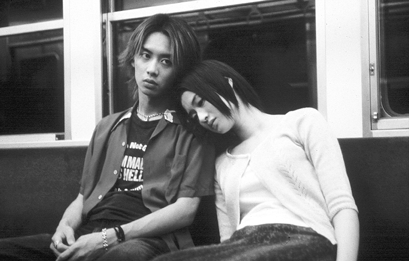Suicide, strange deaths, and at the end a ray of hope
From the late ‘80s through the mid-‘90s, Miramax did a terrific job exposing American audiences to European filmmakers, including Peter Greenaway, Pedro Almodovar, and Krzysztof Kieslowski. This interest died around the time Kieslowski retired and “Pulp Fiction” became a huge hit.
The company bungled its chance to introduce Americans to Abbas Kiarostami, Wong Kar-wai, and Takeshi Kitano. Ten years after the two-week New York run of Kiarostami’s “Through the Olive Trees,” Miramax has yet to release it on VHS or DVD. Now that Harvey and Bob Weinstein have ceded control of Miramax entirely to Disney and moved on to their own new company, we may reap the benefits of their extensive back catalogue of unreleased films.
The Weinsteins acquired the rights to Kioyoshi Kurosawa’s “Pulse,” made in 2001, several years ago in order to make an American remake. That film is slated to come out next year; in the meantime, they’ve made the wise move of licensing the original version to another distributor.
After a puzzling first scene on a boat, featuring Kurosawa’s favorite actor, Koji Yakusho, who doesn’t reappear until the end, “Pulse” centers on a group of friends, all in their early 20s. Taguchi (Kenji Mizuhashi) stops showing up for work. A coworker visits him, finding him behaving strangely, before Taguchi hangs himself in her presence. Soon after, Taguchi’s friends’ computers start showing ghostly images of him. Kawashima (Haruhiko Kato) turns to Harue (Koyuki) for advice after his computer starts dialing itself on the Internet automatically and asking him, “Do you want to meet a ghost?” One by one, the group gets picked off as ghosts start taking over Tokyo.
Recent Japanese films suggest not all Japanese share the happy-go-lucky attitude towards technology often associated with that nation. The “Ring” series pivots around a cursed videotape. Sion Sono’s “Suicide Club” posits a pop group promoting a wave of teen suicides through seemingly innocuous songs about e-mail. “Pulse” reflects some of these anxieties, but it’s not primarily concerned with social commentary. The loneliness it describes long predated computers, even if the film suggests that they further it along.
Like the films of David Cronenberg and George Romero, “Pulse” investigates what it means to be human. What differentiates us from computers or ghosts? In an overly blunt scene, a character explains the film’s view of human interaction via a screen saver—if two dots get too close, they die, yet if they get too far apart, they’re drawn towards each other. From the start, “Pulse” offers a vision of isolation. When Taguchi’s friends head out to his apartment, Kurosawa shows two characters on separate trips sitting in the middle of the same empty bus.
Love is missing from these characters’ lives. No one has a boyfriend or girlfriend. Their relationships with their parents are minimal; one describes them as “irrelevant.” Friendship is the only thing keeping them afloat. Ultimately, it’s what marks them as human—ghosts say that the afterlife is an endless circle of loneliness. However, the characters are passive even before exposure to the ghosts and become zombie-like quickly after interacting with them. The final protagonist turns out to be a character introduced only in the film’s last third. The film’s scariest moments don’t involve ghosts, but instead Tokyo’s desolate streets. Even the three on-screen suicides are relatively bloodless.
Kurosawa uses computer-generated imagery creatively. Rather than trying to make it look seamless, he brings out the creepy artificiality of his world and creates effects that couldn’t be achieved otherwise. “Pulse” is full of blurred images, and visual and audio glitches. Losing one’s grip on life means going out of focus. Deploying relatively few close-ups, he makes rich use of the background—at one point, a woman stands close to the camera while someone in a tower far above her prepares to jump. Takeshi Haketa’s score adds to the queasiness. Alternating between loud, sweeping strings and subterranean bass rumbles, it suggests a distorted take on Bernard Herrmann’s music for “Psycho.”
While “Pulse” was made before 9/11, some of its images—a plane flying into a building, TV shots of missing people—now look like a premonition of the attack. The suicide victims turn into charcoal outlines, recalling the shadows burnt into concrete after the nuclear bombings of Hiroshima and Nagasaki. Kurosawa’s films tend to be enigmatic; none of the mysteries of “Pulse” are clearly explained, even if theories are offered. The director has frequently said that he sees something positive in the apocalyptic endings of several of his films. They offer the chance for a new beginning. These endings are best read metaphorically; if taken literally, they might seem like justifications for violence.
In “Pulse,” the boundary between life and death dissolves, but one woman learns the value of friendship and transcends her loneliness. Haunted by the past and scared by the present, the film nevertheless offers a faint ray of hope.
gaycitynews.com



































